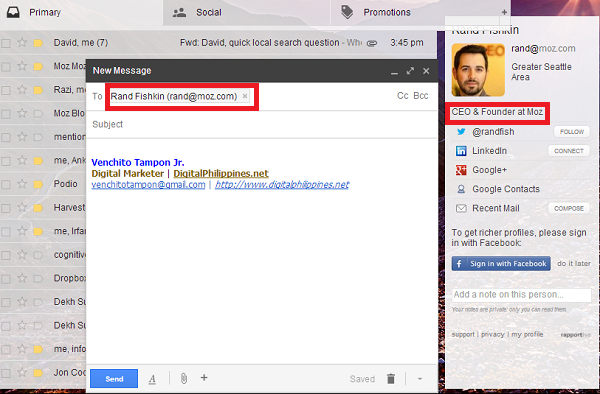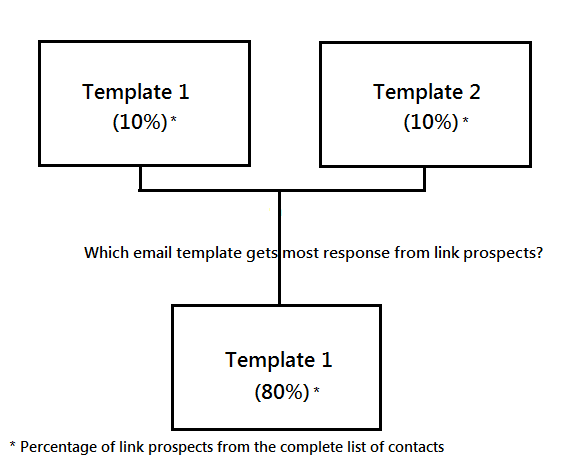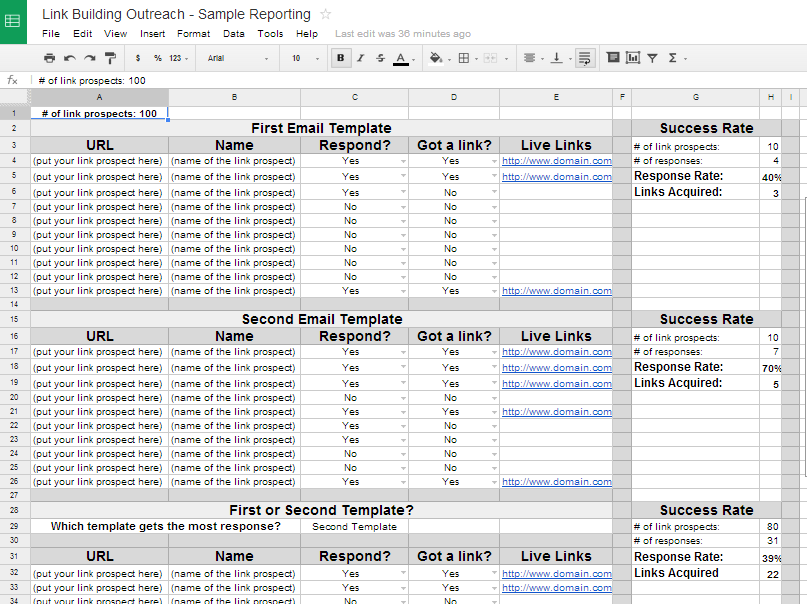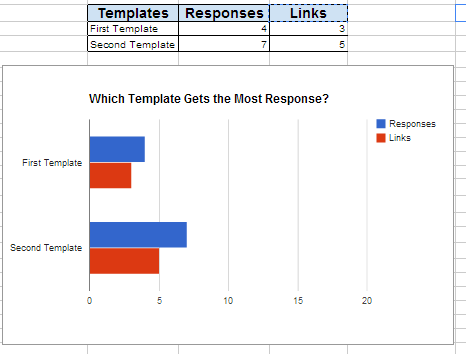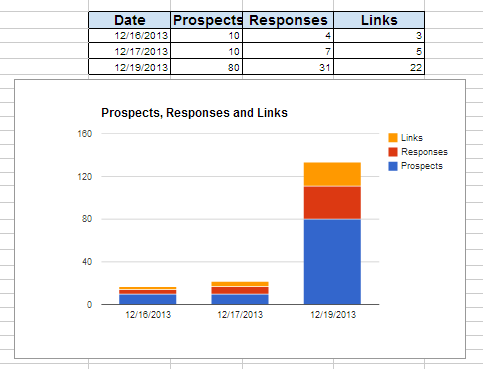by Venchito Tampon Jr | Last Updated on January 12, 2022
Outreach is one of the biggest parts of the job for link builders especially if they are just starting to build relationships with a few people in their respective industries.
As a matter of fact, in most link building campaigns, outreach consumes almost half of the time used for link building (probably because of the long inbox dialogue that happened before getting the link that they want).
I know you’ve read a lot of articles discussing how outreach should be done with care and personalization. You may have thought that the process is completely complicated in terms of the needed resources, link building tools, and time budgeted for this activity.
This boils down to one viewpoint: link builders are only for the persistent ones.
Well, there is nothing wrong with that. But in seeing outreach as a too-complicated activity in link building is not good thinking.
In this post, I want to share with you a simple guide on how you can effectively conduct your outreach campaign.
But before delving into the different steps used in this guide, let me give you some misconceptions about the outreach that I know many link builders are still thinking of right of this moment.
Misconceptions About Link Building Outreach
Lengthy emails are more likely to get higher response rates than shorter ones.
One factor that may cause an increase/decrease in the response rate is the length of the email.
Actually, there is no guarantee that a lengthy email yields a higher response rate than a shorter one. The number of words that must be used would mostly depend on the type of outreach you’re doing.
For product reviews, you might write a longer email since you need to explain the unique proposition of your product and use more words to entice your blogger to write a review about it.
While if you’re just sending an email to a person to let him see/share your content, you just need to be direct to the point and use 3 to 5 sentences to tell him your offer (since end-receivers in that kind of outreach don’t want to read fluffy words in their inbox).
The main point is that you shouldn’t care too much about the number of words that you will use in your emails. The more concise your email yet should be understandable, the better.
Outreach is all about personalization.
Personalization is only the first thing to consider in outreach. The next thing is authenticity. People are not always looking at the number of personal information that you know about them.
Don’t ask yourself, “how much information do I know about my prospect?”. But instead, answer this question, “How much do I care about my prospect?”.
People don’t care how much you know until they know how much you care. – J. Maxwell
Use reciprocation to your advantage. Offer your prospect something valuable that might interest him to do a favor for you (e.g. give you a link).
If you care about what he needs, he’ll be more likely to give you what you want.
Now you know some misconceptions about outreach, it’s time to understand the steps to a successful link building outreach.
How To Do Link Building Outreach
1. Goal Checking
You will not create again a list of goals for your link building campaign. You had this before, right? Now, you need to stick them into your mind while doing your outreach.
Remember that your link building goals should align with the operations of your business and should be more than just getting high quality backlinks. Check your list if the goals noted can bring success to your brand. Otherwise, make a revision with them.
Here are some goals that you’ve thought of when doing your link prospecting in the first place (and you know they can add value to your business):
Improve your online reputation management (ORM)
All brands want to impress their clients/customers as much as possible. Unfortunately, this doesn’t happen only by creating good and high-quality content targeted for its target audience. Your content must be seen by them in any way that you can (exert more effort on relationship building to get better results).
How can they see your content? Through outreach.
Unlike PPC ads and other paid marketing efforts, outreach is a free-to-use method to get your content in front of your audience and let them take an action for your brand (i.e. sign up for your newsletter).
Outreach tactics to improve your ORM:
- Content distribution to influential bloggers/webmasters (e.g. guest posts)
- Participation in industry-related communities (e.g. forum marketing)
- Pitch bloggers who do weekly/monthly interviews and ask if they can include your content assets.
- Find journalists and tell them your brand stories (use Followerwonk to search for them).
Increase in referral traffic
Link building is useless if it doesn’t add traffic to your site. It may seem good to see one link in your backlink profile but if it doesn’t give your site new visitors, then you are not squeezing the most value out of your link building efforts.
Outreach is your first initiative to increase your site’s referral traffic.
You let your prospects identify your requests (i.e. content placement) and why you are worthy for such. If they accept your requests, you can submit your content and get a link from that effort (contextual links from your guest post or from an introductory paragraph of your infographic).
And from the proper placement of your link, you can receive referral traffic from your prospect’s page/site.
Outreach tactics to increase your online traffic
- Ongoing content distribution to high-quality media outlets (e.g. regular content contribution)
- Engagement in industry-related conversations that are mostly found in community threads
- Massive interviews (pitching bloggers who have an interview section on their blogs and incentivizing them to conduct an interview with you)
- Build expertise-based relationships with key influencers in the industry (to get natural links that can bring new followers/visitors to your site).
Rank for competitive and highly convertible keywords
Having your content placed on the top five spots of search results for targeted keywords could bring continuous search traffic to your website. If targeted keywords have high conversion rates (i.e. buying keywords), an increase in leads/sales is possible as well (conversion link building).
Outreach tactics to rank for competitive and highly convertible keywords
- Increase in content promotion efforts with variations of targeted anchor texts for higher chances of ranking for related terms.
- Conversation participation in online communities (target keyword-based online communities – i.e. forums that have your target keywords in the threads’ titles).
- Pitching site owners that have links pages (placing your link in the page through broken link building and/or paid methods).
- Reaching out to social sharers of a successful existing content (asking them to also promote your content asset).
Enhance branding and market awareness
Online presence targeted to customers is the first reason why brands go online. When people search for a product/service to use, they want their offerings to be seen on different web places where their customers are actively participating (forums, blogs, Q&A sites, etc..).
Outreach makes this branding effort a lot easier since you only need to reach out to a few people who are influential in your niche which can speed up the process of your brand promotion (the higher is their engagement, the faster is the amplification).
Outreach tactics to enhance branding and market awareness
- Pitch bloggers who write high-quality product reviews (incentivize them by giving a free trial of the product, payment, or both).
- Get journalists to cover stories/news about the new developments of your brand.
- Sending emails to authoritative media outlets who’re seeking insights/knowledge from key influencers (include your personal or your brand’s achievements to secure a higher response rate).
- Continuous engagement in web places where the target audience participates.
2. Information Gathering
You need two things before you gather the needed information of your link prospects:
- List of identified link building goals in your notepad/word document with corresponding actionable tactics to achieve each goal.
- Spreadsheet of qualified link prospects (approved by your SEO manager/link building specialist).
When you now have these two lists, proceed to information gathering. Information gathering is simply the process of finding the important contact details of the must-pitch/approved link target.
Below are the details that you need to look for each link prospect:
- First name (with credentials such as Dr. to address the person ethically)
- Email address (methods to find this will be discussed later)
- Company position of the link prospect (optional)
If you come across a website that has only one website owner, it is easy for you to see his contact details by simply looking at the About Me page.
However, for several owners/persons of one website, you have several contact details to choose from. In this case, you need only to select one or two from the list and have his/her contact info placed on your spreadsheet. But how?
Go back to your link building tactics list and identify the person you need to contact for each link building tactic.
- Guest posts – blog/content manager
- Product reviews – content manager
- Interviews – specific staff member or the site owner (if not available, find the closest person of your interviewee and just ask him if he can direct you to your target person)
- Round-up posts – blog manager
- Get people to see your content – blog manager, social media manager
- Contest – page creator (when there’s a page for event inquiries)
- Event resources – event manager, support system person,
- Discounts/coupons – content manager
- Broken link building – page creator, original webmaster,
If you can’t find the right person to pitch for your link building activity, look for the last resort – support system manager. Commonly his email address would be info@domain.com or support@domain.com. Make sure you ask for permission/request to him to help you connect with your prospect.
Now that you have identified the right person to get in touch with, you can now find all the important details of that person.
First Name
There is no need to explain this further. But if you’re doing link building for commercial websites, you have to include the credentials of your link target (i.e. Dr. if he is a doctor).
I discovered that this is important since the person would want to address properly his name either by phone or via email.
Here are the places where you can find the email address of your link prospect:
- Contact Us Page. Look at the different sides of the homepage (top, bottom, sidebars) to find a link pointing to the contact us page.
- Contact Form. Find the email ad at the top of the contact form (somewhere in the description/paragraph above it).
- Employee Bio Page. For prominent brands, there might be a bio page for each of the brand’s staff members or employees. If you can’t find your prospect’s bio page, search for his personal blog/site (it may have been stated in the bio page, then find his email address on his own website).
- Google search. Use this query: site:domain.com @gmail.com OR [at] [dot] to see his email address in the search results.
- Linsy.me with Rapportive. Type in the name and/or the site of your link prospect in Linsy.me and place each and/or all of the email addresses in your email message (see the image below). Make sure you install Rapportive in your Gmail account to ensure that he is the right person you’re looking for.
I also recommend using Buzzstream or Citation Labs Contact Finder for easy identification of email addresses.
Company position of the link prospect
You can add this detail to your email to make your message more personalized, knowing that this can catch the interest of your link target (since you’ve done a little bit of research to get that small personal detail).
3. Segmentation
Before doing outreach, I categorize all my contacts based on the link-based metrics (i.e. DA) I’ve pulled out for each of my link prospects. This will help me prioritize my list of contacts as to which of them should I first reach out to.
The three categories that I used in this phase are:
High – Create the most customized outreach email. Offer an additional value to your pitch. For instance, you want the blogger to write a review about your product, you may want to add another offering (i.e. monetary value) to ensure a positive response.
Medium – Use a template that needs only revision in its intro paragraph. Include details on how you landed on the website of your link prospect.
Low – Use a standardized template to scale your outreach. The template must only require little to no revision.
Add a column to your spreadsheet for contact segmentation. Then proceed to create outreach templates for the two categories (medium, low).
4. Outreach Template
For your first category (High), you might not need an email template since you will write highly customized emails for each of your link targets.
However, for the other two categories, you want to have an outreach template to speed up the process (especially if you’re reaching out to 500 to thousands of contacts).
There are three outreach principles that I always keep in mind when I create an email template:
- Offering. What do you offer to your link target? Is it free content? Product or service? Sponsorship? This must be the first thing your link target must be able to see at the top of your message.
- Unique Proposition. How different is your offer from other offers? If you’re providing the same value then why would they bother to reply back to you?
- Call to Action. The end of your email template should get your prospect to take any action (give you feedback, answer your question, etc..). Be careful not to ask immediately for a link. It will just decrease your success/response rate.
The basic formula to create an outreach template is this (from SEER Interactive’s post):
[Asset] for [Blog/Website Name]
Hi [First Name],
[Brand] [thing brand is offering]. [CTA].
Thanks,
[Your Name
So if you’re outreaching someone for a guest post, your email template may look like this:
Subject: [New Content / Guest Post] for [Blog/Website Name]
Hi [First Name],
[Brand] would like to contribute an article about [topic]. Is this something you’d be interested in?
Thanks,
[Your Name]
Add variations to your email template to create multiple templates and test which one is the most effective. For instance, you want to test the best place to put your CTA offer.
In this case, you can create two templates: one template includes CTA in the intro paragraph; the other one has the CTA at its end.
The more you do testing, the more you improve your outreach.
Real Life Email Outreach Templates
Guest Post
Hey [First Name],
I saw that you’re the founder at [Site] and I wanted to get in touch.
I am looking to write about the topic “[topic]”.
[Why do you want to write about that subject?]
I’m sure that this topic would catch the interest of your readers.
What do you think about this? If you’re interested, I am happy to get something written up and sent over to you – or if you have another topic you’d like to see covered, I am more than happy to write on that.
Here are some of my posts I’ve written on other blogs:
[URL 1]
[URL 2]
[URL 3]
Thanks,
[Your Name]
Results:
Response rate 79%: (11/14)
Links acquired: 11+ (with 2nd-tier links for this post)
Sample links:
- Guest post for Cognitive SEO (DA 50)
- Guest post for Raven Tools (DA 73)
- Guest post for Site Beginner (DA 41)
Round-Up Post
Hi [First Name],
I’m doing an expert round-up on my site and I know that many people would love to hear your thoughts to this question:
[Question]
You can include images (e.g. screenshots) and videos to support your idea.
I know that this will be a great resource for [industry] today. That’s why I want to include your tip (since you’ve been sharing useful strategies/tactics about [topic] on [Site]).
Thank you for your answer in advance, [First Name].
Kindest regards,
[Your Name]
Results:
Response rate: 52% (51/99)
Links acquired (linking to this round-up post): 8+
Sample links:
- Search Engine Land (DA 92)
- Zen Optimise’s Weekly Optimizer (DA 35)
- Wow Internet’s Weekly Round-up (DA 42)
5. Execution
Now it’s time for you to do the outreach. Here are some tools that you can use for the execution phase:
- Gmail with Undo, Boomerang, and/or Yesware add-ons.
- Buzzstream (freemium)
- Marketo Sales Connect (freemium)
Among these tools, I personally use Gmail since I find it convenient and easy to use. However, Gmail and other email service providers can limit your outreach efforts such as handling multiple inbox dialogues and tracking responses from link targets.
If you are tight on your budget, you can consider Gmail and Excel spreadsheets as your outreach tools.
Here are a few tips to get the most value out of the said tools:
- Use canned responses in Gmail for easy template creation. You can even include your subject line in your email template so you can just copy and paste it in the subject line once you write the draft or send the message already (this is effective if you have long subject lines).
- Install the Undo tool in Gmail so you can easily undo the message if you still don’t want to send it (i.e. you remember some grammatical errors in the message).
- Use split testing in outreach. Create two different email templates (you add variations to their subject lines). Send an email message to the first 10% of your contacts. Send another one to the other 10%. Wait for 1-2 days for their responses. If they don’t respond, check each of your templates and see which details you can improve to get more replies. Select one from the two templates that get the most response and use it to reach out to the remaining 80% of your link prospects.
Here’s a diagram to help you with split testing:
Track the dates when the person replies back to you and when the link goes live. It will give you an idea of which week/month gets higher response rates (i.e. December is not a good season for outreach since most (all) are busy for the celebration).
- Allot one week of the interval before you follow up on your contacts. Check first their pages/sites if they had linked to you already. They might forget only to tell you your live links.
- Continue to build relationships with your prospects. You might get another link from them in the future (if you need be).
6. Reporting
If you can measure it, you can improve it. This saying is always applicable in outreach. After you send out messages to your target linkers, you have to track the response rate and the number of links you acquired from them for the following reasons:
- You can have a better understanding of which template gets the most response and certainly add/change details to the template to get better results.
- You can estimate your industry’s link acquisition rate for a certain portion of contacts (2% rate for the first 10% of the whole list).
- You can determine which day of the week yields the highest results in outreach.
There are still a lot more reasons why you need reporting in link building outreach. But the above reasons are what you need the most to improve your outreach efforts.
To simplify the reporting, I created a tool that will help link builders (including me) to measure the success that we’re doing in the outreach process.
Link Building Outreach – Reporting Spreadsheet
As you can see, I applied split testing in the execution and reporting phases of the outreach.
You can easily track the success rates for the first split (10%), second split (10%), and last split (80%) of the activity. You just need to put the important details in the spreadsheet:
- URL of your link target (page/site)
- Name of your link target
- Yes/No for the response section
- Yes/No if you get a link from the prospect
- URL of links that you acquired
The tool will automatically count the response rate and a number of links that are lived for each outreach split.
The spreadsheet could also give you visual representations of the number of links and percentage of responses for a part of the whole portion of your list of contacts.
I will update this tool in the future to track and analyze more needed details in outreach.
The Author
Venchito Tampon Jr
Venchito Tampon is a Filipino Motivational Speaker, Corporate Trainer, and a Leadership Speaker in the Philippines. He is the CEO and Co-Founder of SharpRocket, a link building agency. With a decade of experience, Venchito has a proven track record of leading hundreds of successful SEO (link builidng) campaigns across competitive industries like finance, B2B, legal, and SaaS. His expert advice as a link building expert has been featured in renowned publications such as Semrush, Ahrefs, Huffington Post and Forbes. He is also an international SEO spoken and has delivered talks in SEO Zraz, Asia Pacific Affiliate Summit in Singapore, and Search Marketing Summit in Sydney, Australia. Check out his other businesses, Hills & Valleys Cafe, Blend N Sips and Saas Pursuit.
How our LINK BUILDING AGENCY builds 250 links/mo consistently using Predictable Link Building Methodology™…
- Using a SIMPLE and PROVEN system
- Using a SCALABLE strategy
- No private blog networks
- No creepy outreach emails

